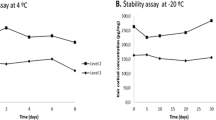Summary
The specific problems of sampling and sample preparation are presented here. The interpretation of sample comminution is discussed, the difficulties of the interpretation of hair analysis are pointed out, ending with consideration of the information available from hair analysis as opposed to that from the analysis of other types of sample and where its limits lie. The application and relevance of hair analysis in industrial medicine today is illustrated and discussed on the basis of several examples from clinical chemistry.
Similar content being viewed by others
References
Bencze K (1984) In: Welz B (Hrsg) Fortschritte in der atomspektrometrischen Spurenanalytik, Bd 1. Verlag Chemie, Weinheim, S 347–363
Bencze K (1987) In: Welz B (Hrsg) 4. Colloquium Atomspektrometrischer Spurenanalytik. Bodenseewerk Perkin-Elmer + Co. GmbH, Überlingen, S. 477–485
Hamilton JB (1951) Ann New York Acad Sci 53:708–728
Anke M, Grün M, Kronemann H (1978) Acta Biol Med Germ 30:1–9
Bencze K (1986) In: Welz B (Hrsg) Fortschritte in der atomspektrometrischen Spurenanalytik, Bd 2. Verlag Chemie, Weinheim, S 207–216
Bencze K (1990) In: Welz B (Hrsg) 5. Colloquium Atomspektrometrischer Spurenanalytik. Bodenseewerk Perkin-Elmer + Co. GmbH, Überlingen (in press)
Clanet P, DeAntonio SM, Katz SA, Scheiner DM (1982) Clin Chem 28:2450–2451
Toribara TY, Jackson DA (1982) Clin Chem 28:650–654
Harrison WW, Yurachek JP, Benson CA (1969) Clin Chim Acta 23:83–91
Hildebrand DC, White DH (1974) Clin Chem 20:148–151
Assarian GS, Oberleas D (1977) Clin Chem 23:1771–1772
Salmela S, Vuori E, Kilpiö Jo (1981) Anal Clin Acta 125:131–137
Hambidge KM, Franklin ML, Jacobs MA (1972) Am J Clin Nutr 25:384–389
Krause C, Ackerschweski S, Babisch W, Chutsch M, Donner L, Haacke M, Lobig K, Neumann D, Neumayr U, Schümann M, Windmüller L, Zwick H (1987) In: Krause C, Chutsch M (Hrsg) Haaranalyse in Medizin und Umwelt. Fischer, Stuttgart New York, S 147–162
Suzuki T (1988) In: Clarkson TW, Friberg L, Nordberg GF, Sager PR (eds) Biological monitoring of toxic metals. Plenum Publ Corp, pp 623–640
Bacso J, Sarkadi L, Koetay E (1982) Int J Appl Radiat Isot 33:5–11
Montagna W, Dobson LR (1969) Hair growth. Pergamon Press, p 585
Rabinowitz M, Wehterill G, Kopple J (1976) Arch Environ Health 31:220–225
Shresta KP, Fornerino I (1987) Sci Total Environm 63:77–81
Trenkwalder P, Bencze K, Lydtin H (1984) Dtsch Med Wochenschr 109:1561–1566
Foo SC, Naim CH, Phoon WO, Lee J (1988) Sci Total Environm 72:113–122
Arnold W (1987) J Clin Chem Biochem 25:753–757
Smith FP, Lin RH (1986) J Forens Sci 31:1269–1273
Grandjean P (1978) Int Arch Occup Environ Health 42:69–81
Hambidge KM, Baum JD (1972) Am J Clin Nutr 25:376–379
Klevay LM (1978) Arch Intern Med 138:1127–1128
Wilhelm M, Hafner D, Ohnesorge FK (1988) Int Arch Occup Environ Health 60:43–50
Stevens BJ (1983) Atom Spectros 4:176–178
Rosmanith J, Einbroalt HJ, Gordon T (1975) Zentralbl Bakteriol Hyg, Abt 1, Orig Reihe B 161:125–136
Hagedorn-Götz H, Küppers G, Stoeppler M (1977) Arch Toxicol 33:275–285
Barret St (1985) J Am Med Assoc 254:1041–1045
Bacso J, Lusztig G, Pal A, Vzonyi I (1986) Exp Pathol 29:119–125
Valković V (1977) Trace elements in human hair. Garland STPM Press, New York London
Kijewski H, Lange J (1977) Z Rechtsmed 80:79–106
Campbell JL, Shata Faiq, Gibson RS, Russel SB, Schulte ChW (1981) Anal Chem 53:1249–1253
DFG — Deutsche Forschungsgemeinschaft. Maximale Arbeitsplatzkonzentration und Biologische Arbeitsstofftoleranzwerte 1989. Mitt. XXV der Senatskommission zur Prüfung gesundheitsschädlicher Arbeitsstoffe. Verlag Chemie, Weinheim
Author information
Authors and Affiliations
Additional information
Based on a lecture delivered to the working circle “Analysen in biologischem Material” — Deutsche Forschungsgemeinschaft Bonn, in Giessen, 16. October 1989
Rights and permissions
About this article
Cite this article
Bencze, K. What contribution can be made to biological monitoring by hair analysis. Fresenius J Anal Chem 338, 58–61 (1990). https://doi.org/10.1007/BF00322786
Received:
Issue Date:
DOI: https://doi.org/10.1007/BF00322786




